Analyzing Child Labor: A Business, Society, and Policy Case Study
VerifiedAdded on 2023/06/04
|12
|3053
|397
Case Study
AI Summary
This case study delves into the pervasive issue of child labor, particularly within the supply chains of major corporations like Nestle. It examines the historical and cultural contexts that contribute to child labor, highlighting the role of poverty and the exploitation of vulnerable children. The case focuses on a twelve-year-old girl, Sametta, working in cocoa bean fields in Cote d’Ivoire, linking her labor to Nestle's supply chain. The study critically reviews Nestle's response to allegations of child labor, including their monitoring and remediation efforts, and discusses the importance of corporate social responsibility and adherence to international labor standards. It also addresses the role of governments in setting minimum employment ages and enforcing labor laws. The analysis emphasizes the need for a multi-faceted approach involving businesses, governments, NGOs, and the public to combat child labor effectively. Desklib provides access to this and other solved assignments for students.
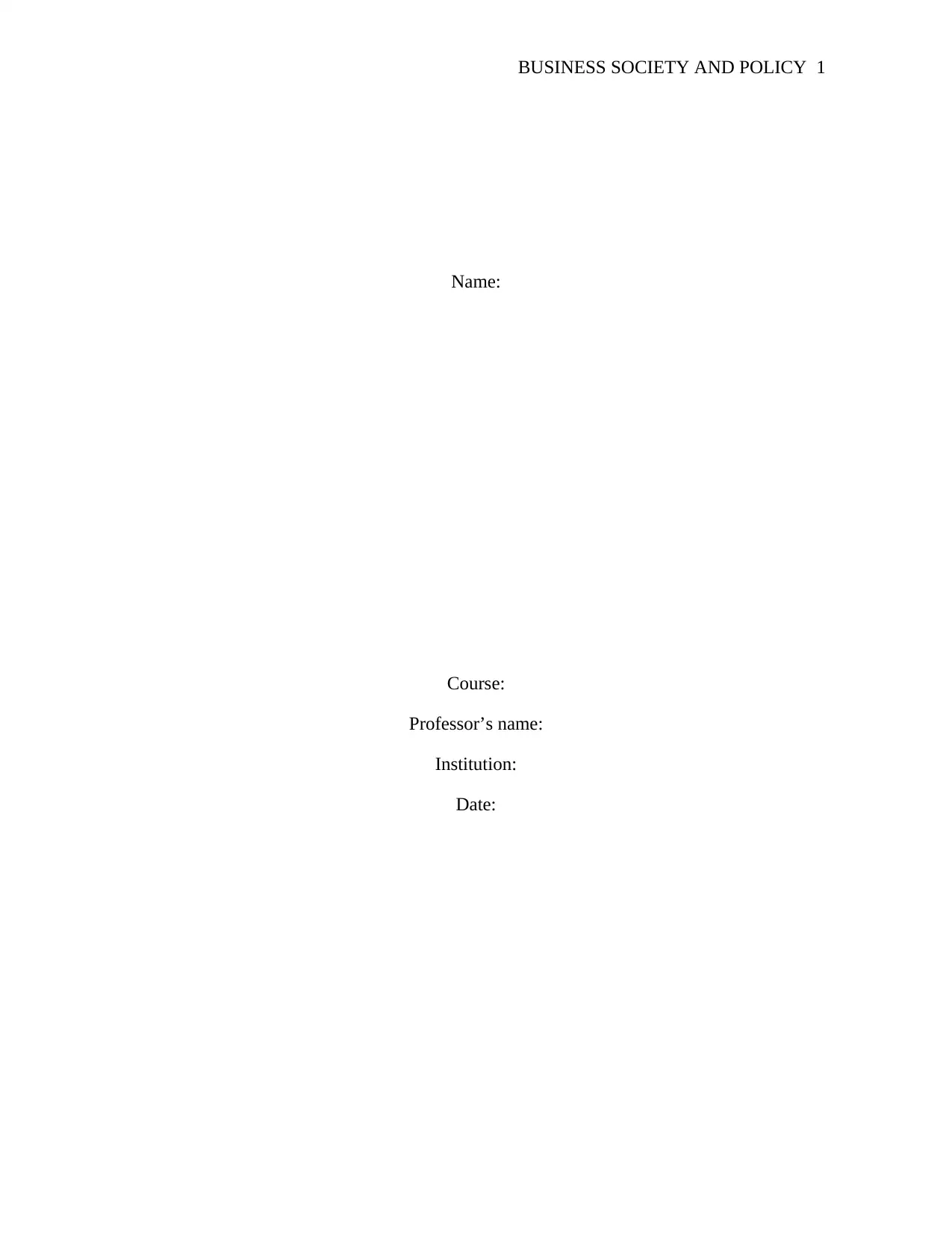
BUSINESS SOCIETY AND POLICY 1
Name:
Course:
Professor’s name:
Institution:
Date:
Name:
Course:
Professor’s name:
Institution:
Date:
Paraphrase This Document
Need a fresh take? Get an instant paraphrase of this document with our AI Paraphraser
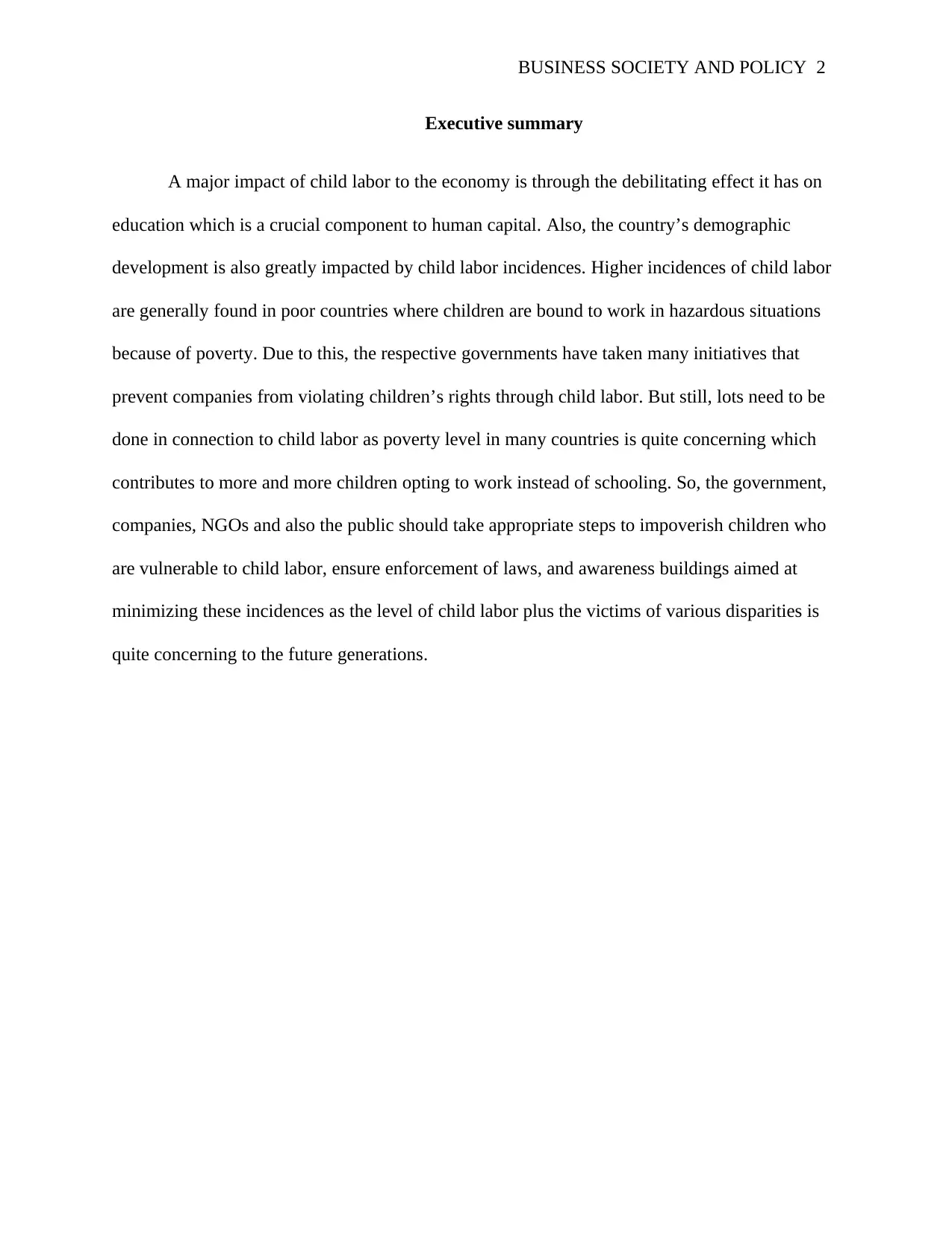
BUSINESS SOCIETY AND POLICY 2
Executive summary
A major impact of child labor to the economy is through the debilitating effect it has on
education which is a crucial component to human capital. Also, the country’s demographic
development is also greatly impacted by child labor incidences. Higher incidences of child labor
are generally found in poor countries where children are bound to work in hazardous situations
because of poverty. Due to this, the respective governments have taken many initiatives that
prevent companies from violating children’s rights through child labor. But still, lots need to be
done in connection to child labor as poverty level in many countries is quite concerning which
contributes to more and more children opting to work instead of schooling. So, the government,
companies, NGOs and also the public should take appropriate steps to impoverish children who
are vulnerable to child labor, ensure enforcement of laws, and awareness buildings aimed at
minimizing these incidences as the level of child labor plus the victims of various disparities is
quite concerning to the future generations.
Executive summary
A major impact of child labor to the economy is through the debilitating effect it has on
education which is a crucial component to human capital. Also, the country’s demographic
development is also greatly impacted by child labor incidences. Higher incidences of child labor
are generally found in poor countries where children are bound to work in hazardous situations
because of poverty. Due to this, the respective governments have taken many initiatives that
prevent companies from violating children’s rights through child labor. But still, lots need to be
done in connection to child labor as poverty level in many countries is quite concerning which
contributes to more and more children opting to work instead of schooling. So, the government,
companies, NGOs and also the public should take appropriate steps to impoverish children who
are vulnerable to child labor, ensure enforcement of laws, and awareness buildings aimed at
minimizing these incidences as the level of child labor plus the victims of various disparities is
quite concerning to the future generations.
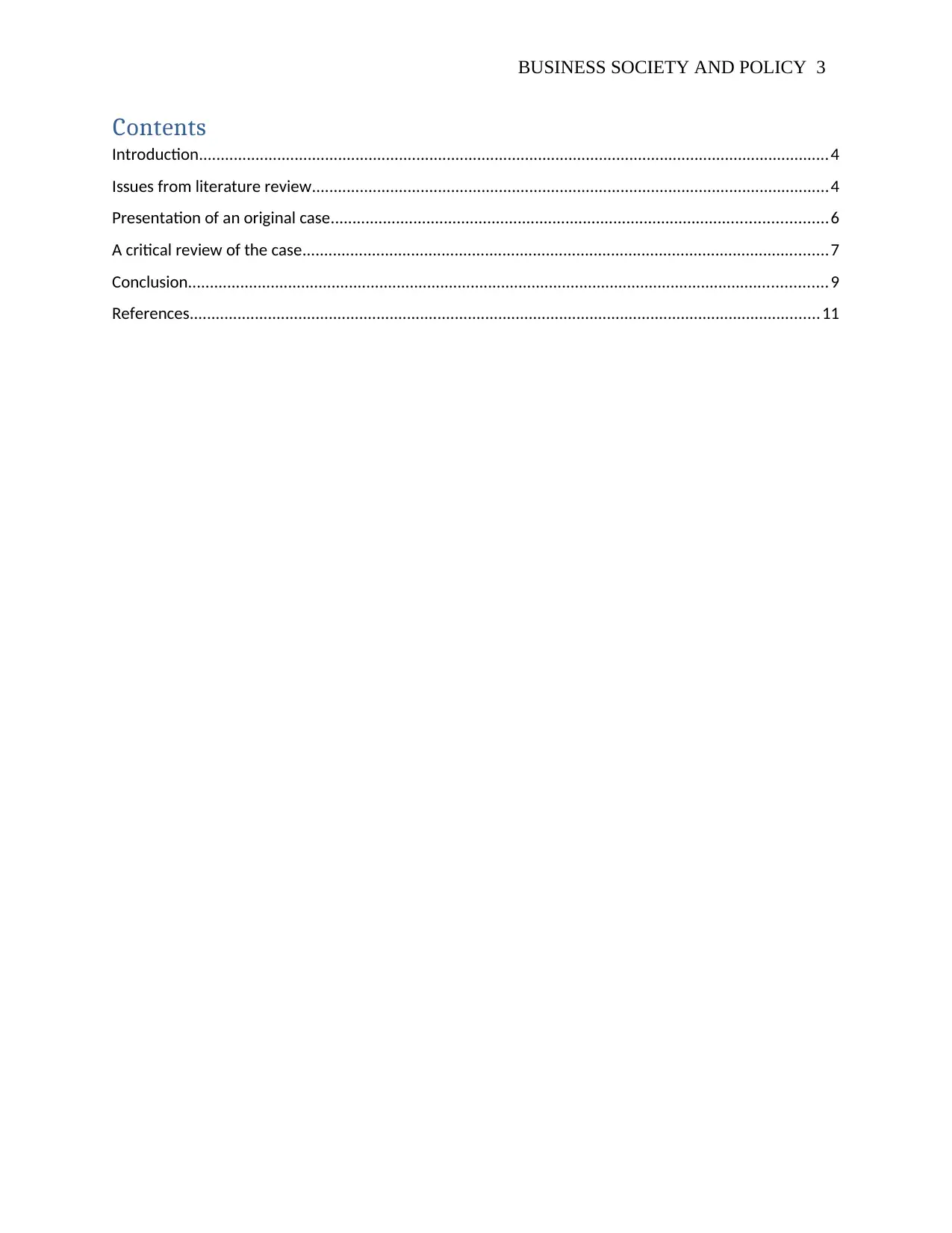
BUSINESS SOCIETY AND POLICY 3
Contents
Introduction.................................................................................................................................................4
Issues from literature review.......................................................................................................................4
Presentation of an original case..................................................................................................................6
A critical review of the case.........................................................................................................................7
Conclusion...................................................................................................................................................9
References.................................................................................................................................................11
Contents
Introduction.................................................................................................................................................4
Issues from literature review.......................................................................................................................4
Presentation of an original case..................................................................................................................6
A critical review of the case.........................................................................................................................7
Conclusion...................................................................................................................................................9
References.................................................................................................................................................11
⊘ This is a preview!⊘
Do you want full access?
Subscribe today to unlock all pages.

Trusted by 1+ million students worldwide
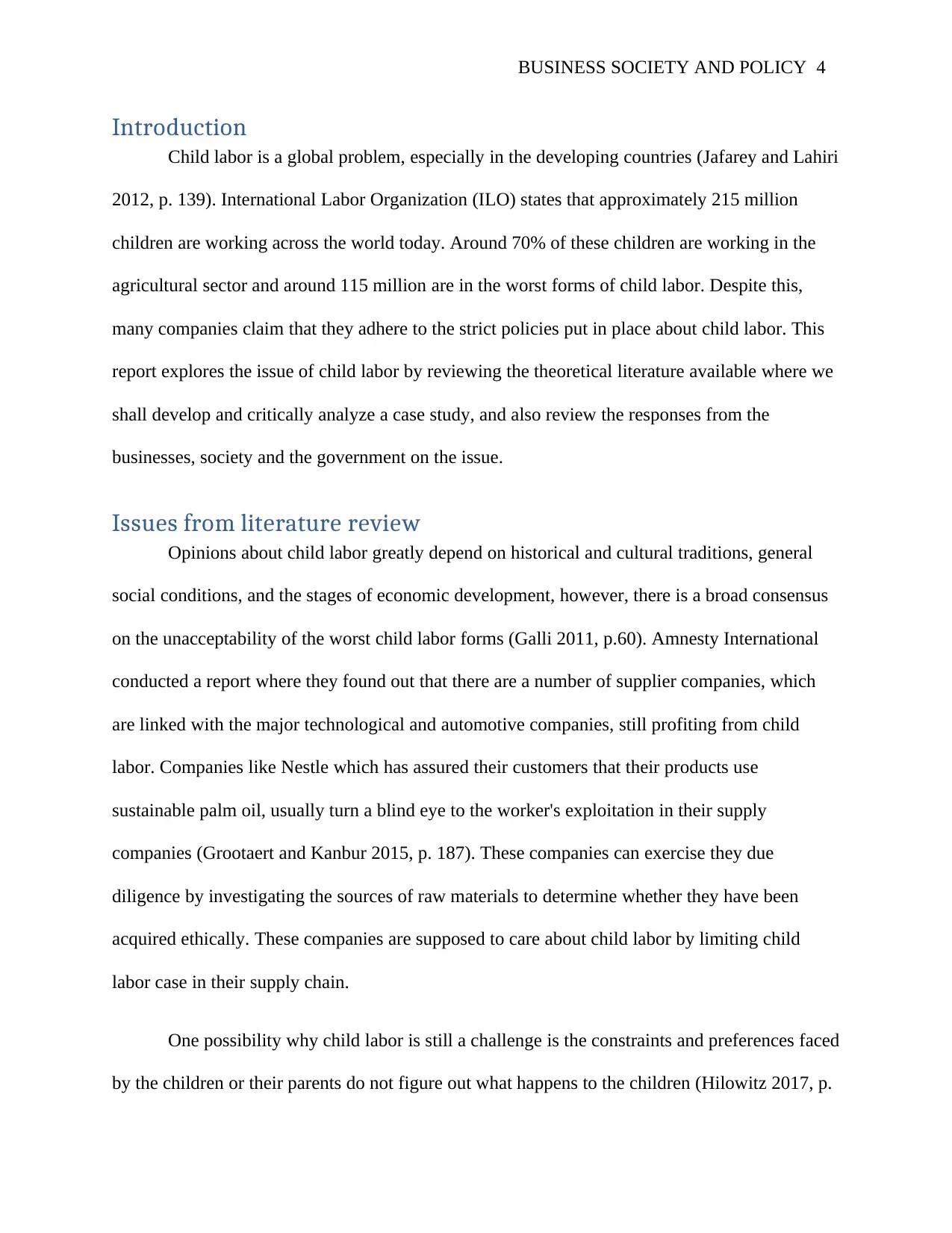
BUSINESS SOCIETY AND POLICY 4
Introduction
Child labor is a global problem, especially in the developing countries (Jafarey and Lahiri
2012, p. 139). International Labor Organization (ILO) states that approximately 215 million
children are working across the world today. Around 70% of these children are working in the
agricultural sector and around 115 million are in the worst forms of child labor. Despite this,
many companies claim that they adhere to the strict policies put in place about child labor. This
report explores the issue of child labor by reviewing the theoretical literature available where we
shall develop and critically analyze a case study, and also review the responses from the
businesses, society and the government on the issue.
Issues from literature review
Opinions about child labor greatly depend on historical and cultural traditions, general
social conditions, and the stages of economic development, however, there is a broad consensus
on the unacceptability of the worst child labor forms (Galli 2011, p.60). Amnesty International
conducted a report where they found out that there are a number of supplier companies, which
are linked with the major technological and automotive companies, still profiting from child
labor. Companies like Nestle which has assured their customers that their products use
sustainable palm oil, usually turn a blind eye to the worker's exploitation in their supply
companies (Grootaert and Kanbur 2015, p. 187). These companies can exercise they due
diligence by investigating the sources of raw materials to determine whether they have been
acquired ethically. These companies are supposed to care about child labor by limiting child
labor case in their supply chain.
One possibility why child labor is still a challenge is the constraints and preferences faced
by the children or their parents do not figure out what happens to the children (Hilowitz 2017, p.
Introduction
Child labor is a global problem, especially in the developing countries (Jafarey and Lahiri
2012, p. 139). International Labor Organization (ILO) states that approximately 215 million
children are working across the world today. Around 70% of these children are working in the
agricultural sector and around 115 million are in the worst forms of child labor. Despite this,
many companies claim that they adhere to the strict policies put in place about child labor. This
report explores the issue of child labor by reviewing the theoretical literature available where we
shall develop and critically analyze a case study, and also review the responses from the
businesses, society and the government on the issue.
Issues from literature review
Opinions about child labor greatly depend on historical and cultural traditions, general
social conditions, and the stages of economic development, however, there is a broad consensus
on the unacceptability of the worst child labor forms (Galli 2011, p.60). Amnesty International
conducted a report where they found out that there are a number of supplier companies, which
are linked with the major technological and automotive companies, still profiting from child
labor. Companies like Nestle which has assured their customers that their products use
sustainable palm oil, usually turn a blind eye to the worker's exploitation in their supply
companies (Grootaert and Kanbur 2015, p. 187). These companies can exercise they due
diligence by investigating the sources of raw materials to determine whether they have been
acquired ethically. These companies are supposed to care about child labor by limiting child
labor case in their supply chain.
One possibility why child labor is still a challenge is the constraints and preferences faced
by the children or their parents do not figure out what happens to the children (Hilowitz 2017, p.
Paraphrase This Document
Need a fresh take? Get an instant paraphrase of this document with our AI Paraphraser
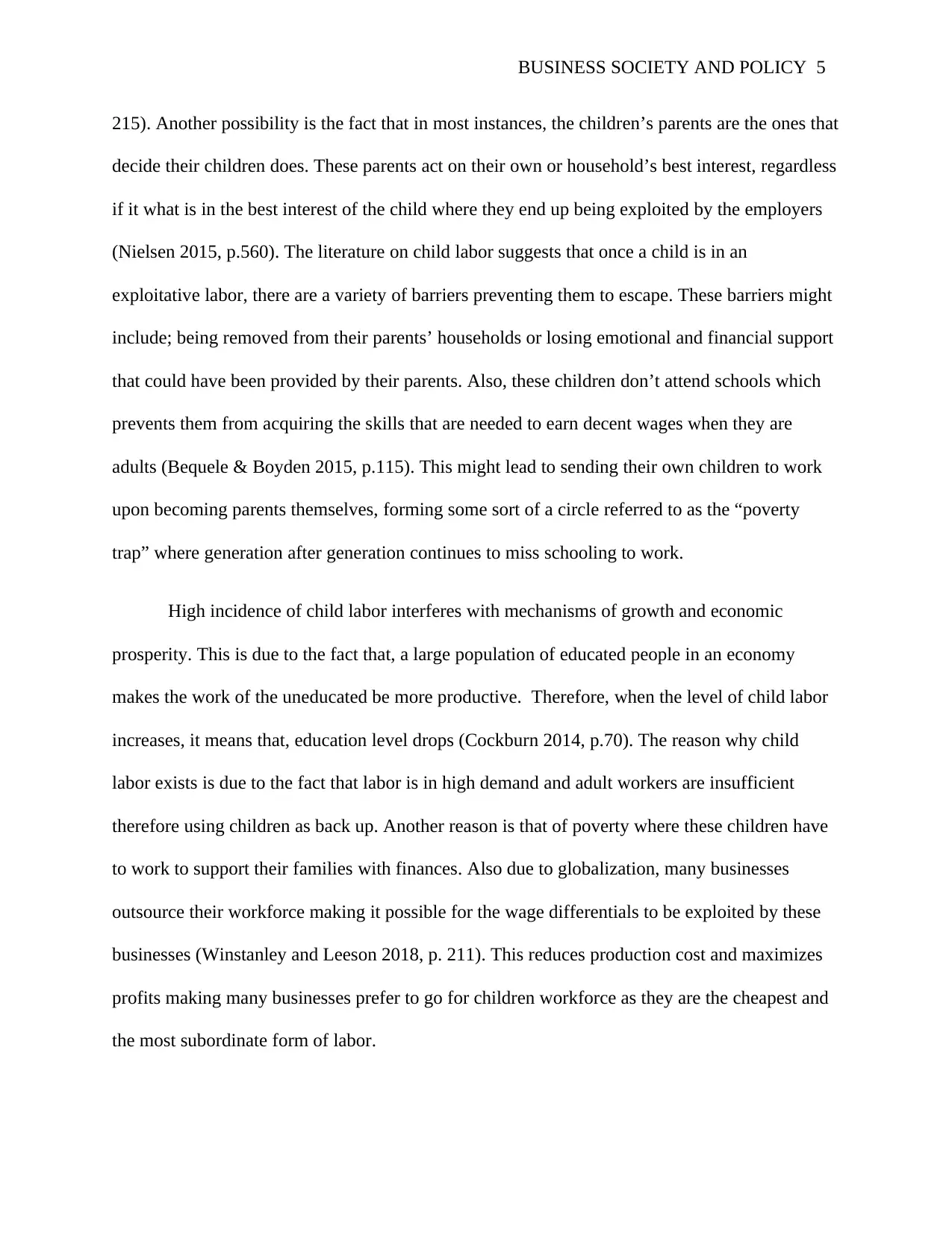
BUSINESS SOCIETY AND POLICY 5
215). Another possibility is the fact that in most instances, the children’s parents are the ones that
decide their children does. These parents act on their own or household’s best interest, regardless
if it what is in the best interest of the child where they end up being exploited by the employers
(Nielsen 2015, p.560). The literature on child labor suggests that once a child is in an
exploitative labor, there are a variety of barriers preventing them to escape. These barriers might
include; being removed from their parents’ households or losing emotional and financial support
that could have been provided by their parents. Also, these children don’t attend schools which
prevents them from acquiring the skills that are needed to earn decent wages when they are
adults (Bequele & Boyden 2015, p.115). This might lead to sending their own children to work
upon becoming parents themselves, forming some sort of a circle referred to as the “poverty
trap” where generation after generation continues to miss schooling to work.
High incidence of child labor interferes with mechanisms of growth and economic
prosperity. This is due to the fact that, a large population of educated people in an economy
makes the work of the uneducated be more productive. Therefore, when the level of child labor
increases, it means that, education level drops (Cockburn 2014, p.70). The reason why child
labor exists is due to the fact that labor is in high demand and adult workers are insufficient
therefore using children as back up. Another reason is that of poverty where these children have
to work to support their families with finances. Also due to globalization, many businesses
outsource their workforce making it possible for the wage differentials to be exploited by these
businesses (Winstanley and Leeson 2018, p. 211). This reduces production cost and maximizes
profits making many businesses prefer to go for children workforce as they are the cheapest and
the most subordinate form of labor.
215). Another possibility is the fact that in most instances, the children’s parents are the ones that
decide their children does. These parents act on their own or household’s best interest, regardless
if it what is in the best interest of the child where they end up being exploited by the employers
(Nielsen 2015, p.560). The literature on child labor suggests that once a child is in an
exploitative labor, there are a variety of barriers preventing them to escape. These barriers might
include; being removed from their parents’ households or losing emotional and financial support
that could have been provided by their parents. Also, these children don’t attend schools which
prevents them from acquiring the skills that are needed to earn decent wages when they are
adults (Bequele & Boyden 2015, p.115). This might lead to sending their own children to work
upon becoming parents themselves, forming some sort of a circle referred to as the “poverty
trap” where generation after generation continues to miss schooling to work.
High incidence of child labor interferes with mechanisms of growth and economic
prosperity. This is due to the fact that, a large population of educated people in an economy
makes the work of the uneducated be more productive. Therefore, when the level of child labor
increases, it means that, education level drops (Cockburn 2014, p.70). The reason why child
labor exists is due to the fact that labor is in high demand and adult workers are insufficient
therefore using children as back up. Another reason is that of poverty where these children have
to work to support their families with finances. Also due to globalization, many businesses
outsource their workforce making it possible for the wage differentials to be exploited by these
businesses (Winstanley and Leeson 2018, p. 211). This reduces production cost and maximizes
profits making many businesses prefer to go for children workforce as they are the cheapest and
the most subordinate form of labor.
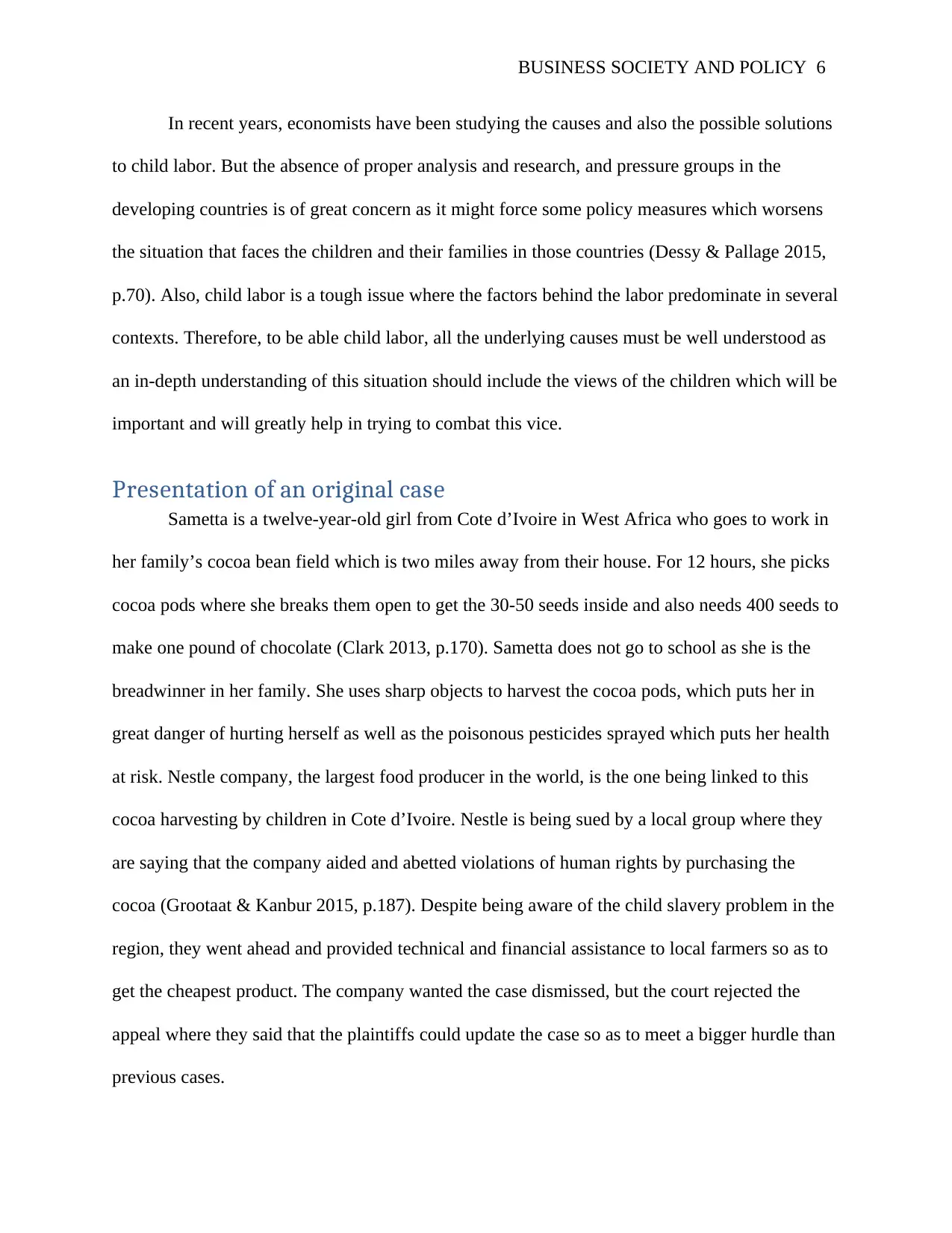
BUSINESS SOCIETY AND POLICY 6
In recent years, economists have been studying the causes and also the possible solutions
to child labor. But the absence of proper analysis and research, and pressure groups in the
developing countries is of great concern as it might force some policy measures which worsens
the situation that faces the children and their families in those countries (Dessy & Pallage 2015,
p.70). Also, child labor is a tough issue where the factors behind the labor predominate in several
contexts. Therefore, to be able child labor, all the underlying causes must be well understood as
an in-depth understanding of this situation should include the views of the children which will be
important and will greatly help in trying to combat this vice.
Presentation of an original case
Sametta is a twelve-year-old girl from Cote d’Ivoire in West Africa who goes to work in
her family’s cocoa bean field which is two miles away from their house. For 12 hours, she picks
cocoa pods where she breaks them open to get the 30-50 seeds inside and also needs 400 seeds to
make one pound of chocolate (Clark 2013, p.170). Sametta does not go to school as she is the
breadwinner in her family. She uses sharp objects to harvest the cocoa pods, which puts her in
great danger of hurting herself as well as the poisonous pesticides sprayed which puts her health
at risk. Nestle company, the largest food producer in the world, is the one being linked to this
cocoa harvesting by children in Cote d’Ivoire. Nestle is being sued by a local group where they
are saying that the company aided and abetted violations of human rights by purchasing the
cocoa (Grootaat & Kanbur 2015, p.187). Despite being aware of the child slavery problem in the
region, they went ahead and provided technical and financial assistance to local farmers so as to
get the cheapest product. The company wanted the case dismissed, but the court rejected the
appeal where they said that the plaintiffs could update the case so as to meet a bigger hurdle than
previous cases.
In recent years, economists have been studying the causes and also the possible solutions
to child labor. But the absence of proper analysis and research, and pressure groups in the
developing countries is of great concern as it might force some policy measures which worsens
the situation that faces the children and their families in those countries (Dessy & Pallage 2015,
p.70). Also, child labor is a tough issue where the factors behind the labor predominate in several
contexts. Therefore, to be able child labor, all the underlying causes must be well understood as
an in-depth understanding of this situation should include the views of the children which will be
important and will greatly help in trying to combat this vice.
Presentation of an original case
Sametta is a twelve-year-old girl from Cote d’Ivoire in West Africa who goes to work in
her family’s cocoa bean field which is two miles away from their house. For 12 hours, she picks
cocoa pods where she breaks them open to get the 30-50 seeds inside and also needs 400 seeds to
make one pound of chocolate (Clark 2013, p.170). Sametta does not go to school as she is the
breadwinner in her family. She uses sharp objects to harvest the cocoa pods, which puts her in
great danger of hurting herself as well as the poisonous pesticides sprayed which puts her health
at risk. Nestle company, the largest food producer in the world, is the one being linked to this
cocoa harvesting by children in Cote d’Ivoire. Nestle is being sued by a local group where they
are saying that the company aided and abetted violations of human rights by purchasing the
cocoa (Grootaat & Kanbur 2015, p.187). Despite being aware of the child slavery problem in the
region, they went ahead and provided technical and financial assistance to local farmers so as to
get the cheapest product. The company wanted the case dismissed, but the court rejected the
appeal where they said that the plaintiffs could update the case so as to meet a bigger hurdle than
previous cases.
⊘ This is a preview!⊘
Do you want full access?
Subscribe today to unlock all pages.

Trusted by 1+ million students worldwide
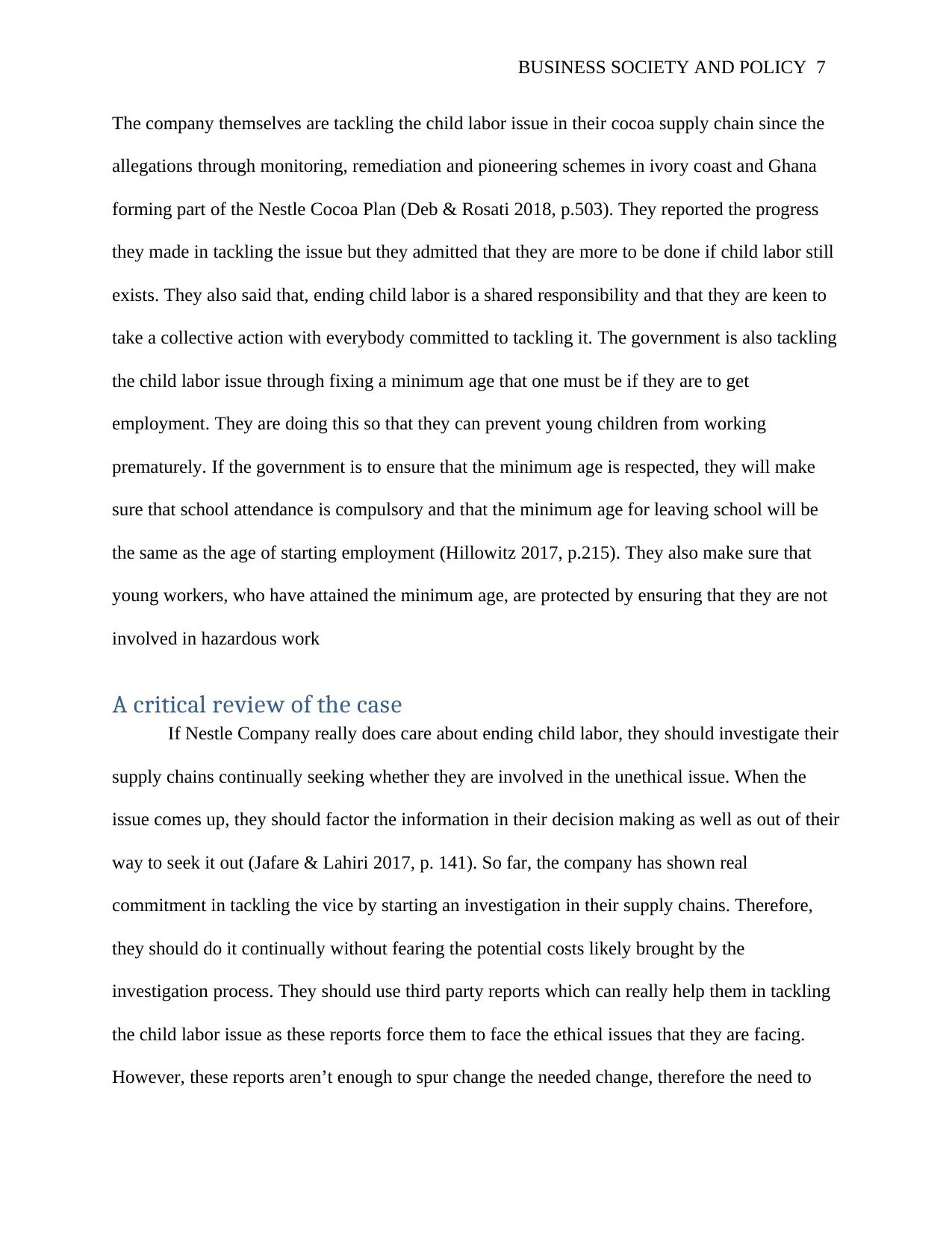
BUSINESS SOCIETY AND POLICY 7
The company themselves are tackling the child labor issue in their cocoa supply chain since the
allegations through monitoring, remediation and pioneering schemes in ivory coast and Ghana
forming part of the Nestle Cocoa Plan (Deb & Rosati 2018, p.503). They reported the progress
they made in tackling the issue but they admitted that they are more to be done if child labor still
exists. They also said that, ending child labor is a shared responsibility and that they are keen to
take a collective action with everybody committed to tackling it. The government is also tackling
the child labor issue through fixing a minimum age that one must be if they are to get
employment. They are doing this so that they can prevent young children from working
prematurely. If the government is to ensure that the minimum age is respected, they will make
sure that school attendance is compulsory and that the minimum age for leaving school will be
the same as the age of starting employment (Hillowitz 2017, p.215). They also make sure that
young workers, who have attained the minimum age, are protected by ensuring that they are not
involved in hazardous work
A critical review of the case
If Nestle Company really does care about ending child labor, they should investigate their
supply chains continually seeking whether they are involved in the unethical issue. When the
issue comes up, they should factor the information in their decision making as well as out of their
way to seek it out (Jafare & Lahiri 2017, p. 141). So far, the company has shown real
commitment in tackling the vice by starting an investigation in their supply chains. Therefore,
they should do it continually without fearing the potential costs likely brought by the
investigation process. They should use third party reports which can really help them in tackling
the child labor issue as these reports force them to face the ethical issues that they are facing.
However, these reports aren’t enough to spur change the needed change, therefore the need to
The company themselves are tackling the child labor issue in their cocoa supply chain since the
allegations through monitoring, remediation and pioneering schemes in ivory coast and Ghana
forming part of the Nestle Cocoa Plan (Deb & Rosati 2018, p.503). They reported the progress
they made in tackling the issue but they admitted that they are more to be done if child labor still
exists. They also said that, ending child labor is a shared responsibility and that they are keen to
take a collective action with everybody committed to tackling it. The government is also tackling
the child labor issue through fixing a minimum age that one must be if they are to get
employment. They are doing this so that they can prevent young children from working
prematurely. If the government is to ensure that the minimum age is respected, they will make
sure that school attendance is compulsory and that the minimum age for leaving school will be
the same as the age of starting employment (Hillowitz 2017, p.215). They also make sure that
young workers, who have attained the minimum age, are protected by ensuring that they are not
involved in hazardous work
A critical review of the case
If Nestle Company really does care about ending child labor, they should investigate their
supply chains continually seeking whether they are involved in the unethical issue. When the
issue comes up, they should factor the information in their decision making as well as out of their
way to seek it out (Jafare & Lahiri 2017, p. 141). So far, the company has shown real
commitment in tackling the vice by starting an investigation in their supply chains. Therefore,
they should do it continually without fearing the potential costs likely brought by the
investigation process. They should use third party reports which can really help them in tackling
the child labor issue as these reports force them to face the ethical issues that they are facing.
However, these reports aren’t enough to spur change the needed change, therefore the need to
Paraphrase This Document
Need a fresh take? Get an instant paraphrase of this document with our AI Paraphraser
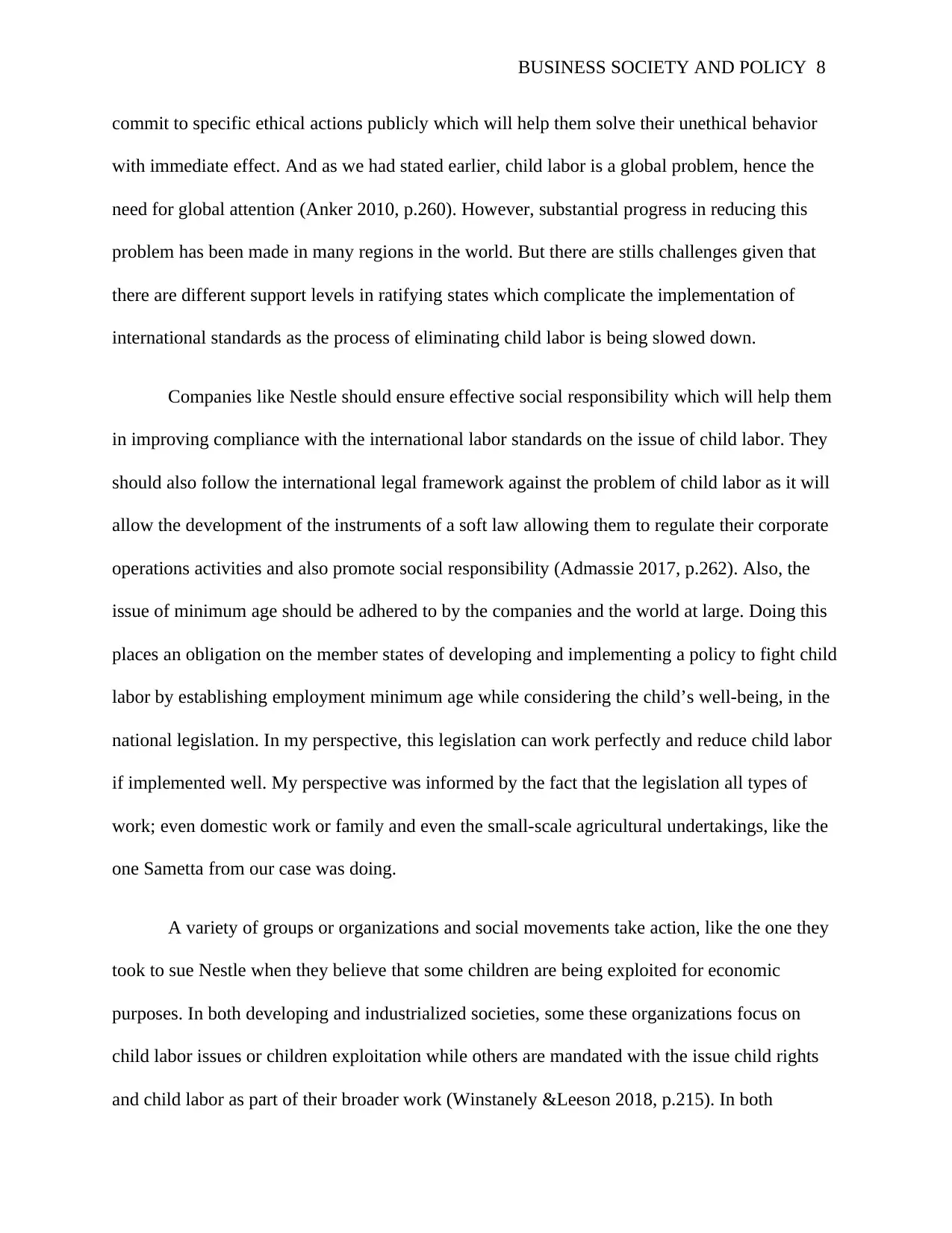
BUSINESS SOCIETY AND POLICY 8
commit to specific ethical actions publicly which will help them solve their unethical behavior
with immediate effect. And as we had stated earlier, child labor is a global problem, hence the
need for global attention (Anker 2010, p.260). However, substantial progress in reducing this
problem has been made in many regions in the world. But there are stills challenges given that
there are different support levels in ratifying states which complicate the implementation of
international standards as the process of eliminating child labor is being slowed down.
Companies like Nestle should ensure effective social responsibility which will help them
in improving compliance with the international labor standards on the issue of child labor. They
should also follow the international legal framework against the problem of child labor as it will
allow the development of the instruments of a soft law allowing them to regulate their corporate
operations activities and also promote social responsibility (Admassie 2017, p.262). Also, the
issue of minimum age should be adhered to by the companies and the world at large. Doing this
places an obligation on the member states of developing and implementing a policy to fight child
labor by establishing employment minimum age while considering the child’s well-being, in the
national legislation. In my perspective, this legislation can work perfectly and reduce child labor
if implemented well. My perspective was informed by the fact that the legislation all types of
work; even domestic work or family and even the small-scale agricultural undertakings, like the
one Sametta from our case was doing.
A variety of groups or organizations and social movements take action, like the one they
took to sue Nestle when they believe that some children are being exploited for economic
purposes. In both developing and industrialized societies, some these organizations focus on
child labor issues or children exploitation while others are mandated with the issue child rights
and child labor as part of their broader work (Winstanely &Leeson 2018, p.215). In both
commit to specific ethical actions publicly which will help them solve their unethical behavior
with immediate effect. And as we had stated earlier, child labor is a global problem, hence the
need for global attention (Anker 2010, p.260). However, substantial progress in reducing this
problem has been made in many regions in the world. But there are stills challenges given that
there are different support levels in ratifying states which complicate the implementation of
international standards as the process of eliminating child labor is being slowed down.
Companies like Nestle should ensure effective social responsibility which will help them
in improving compliance with the international labor standards on the issue of child labor. They
should also follow the international legal framework against the problem of child labor as it will
allow the development of the instruments of a soft law allowing them to regulate their corporate
operations activities and also promote social responsibility (Admassie 2017, p.262). Also, the
issue of minimum age should be adhered to by the companies and the world at large. Doing this
places an obligation on the member states of developing and implementing a policy to fight child
labor by establishing employment minimum age while considering the child’s well-being, in the
national legislation. In my perspective, this legislation can work perfectly and reduce child labor
if implemented well. My perspective was informed by the fact that the legislation all types of
work; even domestic work or family and even the small-scale agricultural undertakings, like the
one Sametta from our case was doing.
A variety of groups or organizations and social movements take action, like the one they
took to sue Nestle when they believe that some children are being exploited for economic
purposes. In both developing and industrialized societies, some these organizations focus on
child labor issues or children exploitation while others are mandated with the issue child rights
and child labor as part of their broader work (Winstanely &Leeson 2018, p.215). In both
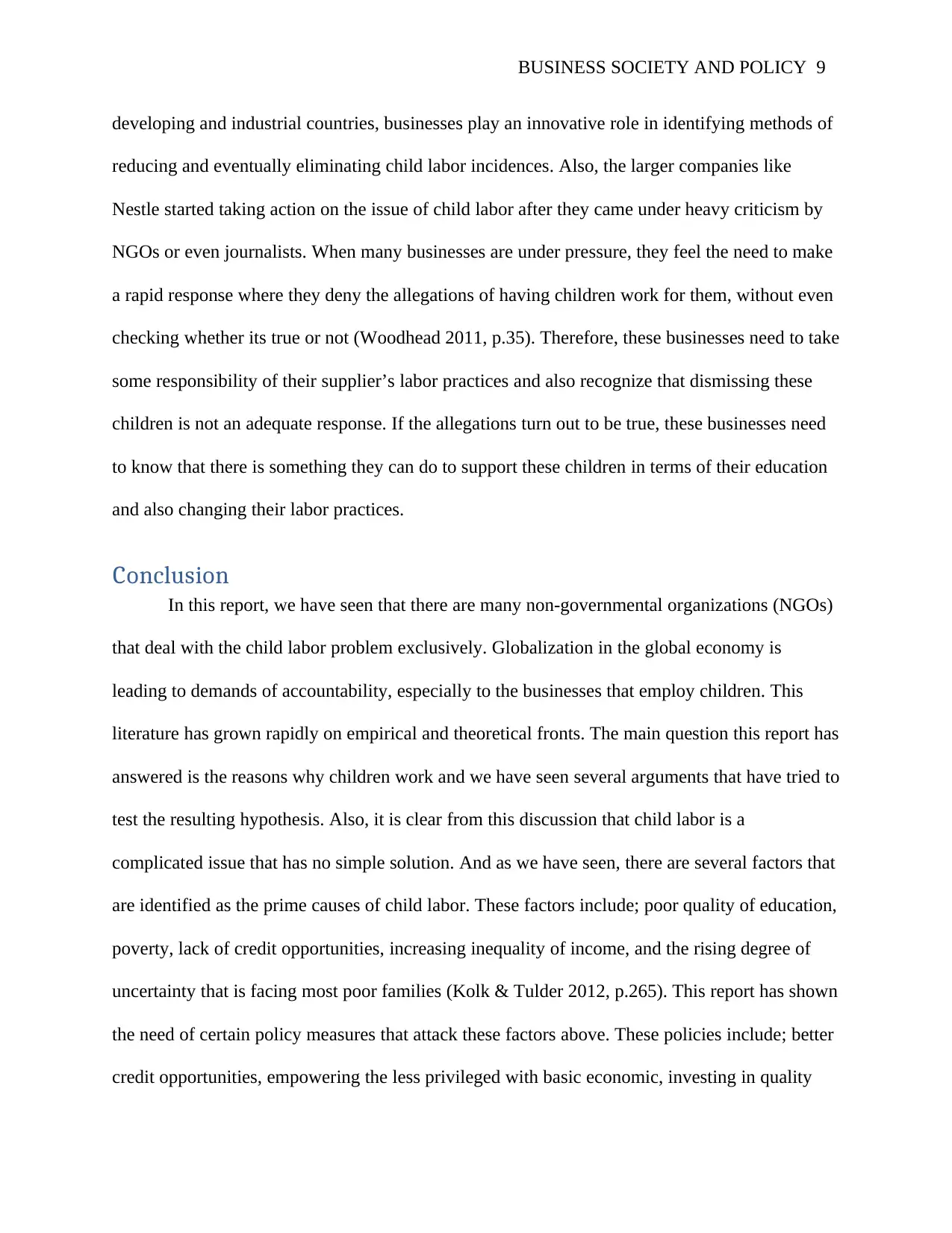
BUSINESS SOCIETY AND POLICY 9
developing and industrial countries, businesses play an innovative role in identifying methods of
reducing and eventually eliminating child labor incidences. Also, the larger companies like
Nestle started taking action on the issue of child labor after they came under heavy criticism by
NGOs or even journalists. When many businesses are under pressure, they feel the need to make
a rapid response where they deny the allegations of having children work for them, without even
checking whether its true or not (Woodhead 2011, p.35). Therefore, these businesses need to take
some responsibility of their supplier’s labor practices and also recognize that dismissing these
children is not an adequate response. If the allegations turn out to be true, these businesses need
to know that there is something they can do to support these children in terms of their education
and also changing their labor practices.
Conclusion
In this report, we have seen that there are many non-governmental organizations (NGOs)
that deal with the child labor problem exclusively. Globalization in the global economy is
leading to demands of accountability, especially to the businesses that employ children. This
literature has grown rapidly on empirical and theoretical fronts. The main question this report has
answered is the reasons why children work and we have seen several arguments that have tried to
test the resulting hypothesis. Also, it is clear from this discussion that child labor is a
complicated issue that has no simple solution. And as we have seen, there are several factors that
are identified as the prime causes of child labor. These factors include; poor quality of education,
poverty, lack of credit opportunities, increasing inequality of income, and the rising degree of
uncertainty that is facing most poor families (Kolk & Tulder 2012, p.265). This report has shown
the need of certain policy measures that attack these factors above. These policies include; better
credit opportunities, empowering the less privileged with basic economic, investing in quality
developing and industrial countries, businesses play an innovative role in identifying methods of
reducing and eventually eliminating child labor incidences. Also, the larger companies like
Nestle started taking action on the issue of child labor after they came under heavy criticism by
NGOs or even journalists. When many businesses are under pressure, they feel the need to make
a rapid response where they deny the allegations of having children work for them, without even
checking whether its true or not (Woodhead 2011, p.35). Therefore, these businesses need to take
some responsibility of their supplier’s labor practices and also recognize that dismissing these
children is not an adequate response. If the allegations turn out to be true, these businesses need
to know that there is something they can do to support these children in terms of their education
and also changing their labor practices.
Conclusion
In this report, we have seen that there are many non-governmental organizations (NGOs)
that deal with the child labor problem exclusively. Globalization in the global economy is
leading to demands of accountability, especially to the businesses that employ children. This
literature has grown rapidly on empirical and theoretical fronts. The main question this report has
answered is the reasons why children work and we have seen several arguments that have tried to
test the resulting hypothesis. Also, it is clear from this discussion that child labor is a
complicated issue that has no simple solution. And as we have seen, there are several factors that
are identified as the prime causes of child labor. These factors include; poor quality of education,
poverty, lack of credit opportunities, increasing inequality of income, and the rising degree of
uncertainty that is facing most poor families (Kolk & Tulder 2012, p.265). This report has shown
the need of certain policy measures that attack these factors above. These policies include; better
credit opportunities, empowering the less privileged with basic economic, investing in quality
⊘ This is a preview!⊘
Do you want full access?
Subscribe today to unlock all pages.

Trusted by 1+ million students worldwide
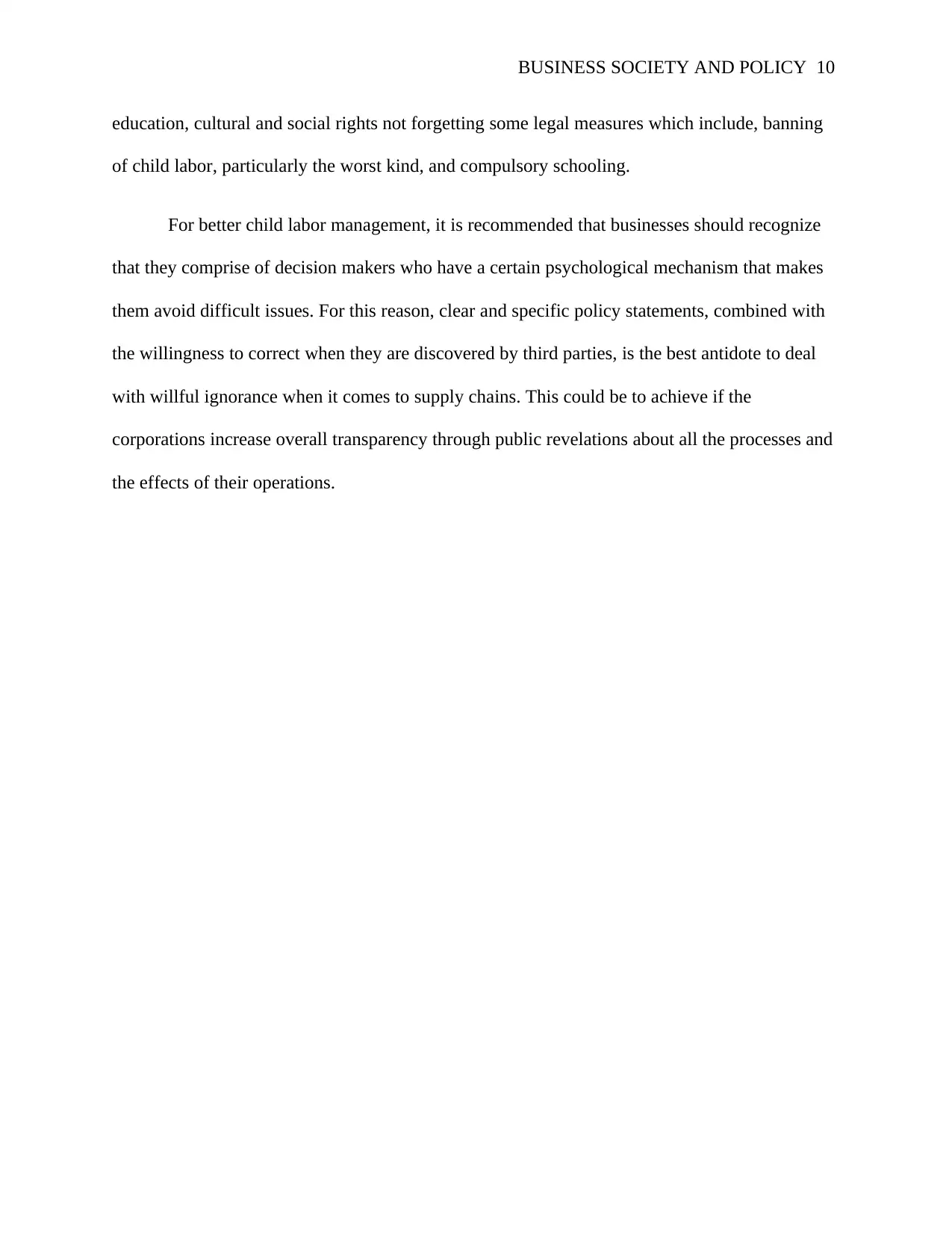
BUSINESS SOCIETY AND POLICY 10
education, cultural and social rights not forgetting some legal measures which include, banning
of child labor, particularly the worst kind, and compulsory schooling.
For better child labor management, it is recommended that businesses should recognize
that they comprise of decision makers who have a certain psychological mechanism that makes
them avoid difficult issues. For this reason, clear and specific policy statements, combined with
the willingness to correct when they are discovered by third parties, is the best antidote to deal
with willful ignorance when it comes to supply chains. This could be to achieve if the
corporations increase overall transparency through public revelations about all the processes and
the effects of their operations.
education, cultural and social rights not forgetting some legal measures which include, banning
of child labor, particularly the worst kind, and compulsory schooling.
For better child labor management, it is recommended that businesses should recognize
that they comprise of decision makers who have a certain psychological mechanism that makes
them avoid difficult issues. For this reason, clear and specific policy statements, combined with
the willingness to correct when they are discovered by third parties, is the best antidote to deal
with willful ignorance when it comes to supply chains. This could be to achieve if the
corporations increase overall transparency through public revelations about all the processes and
the effects of their operations.
Paraphrase This Document
Need a fresh take? Get an instant paraphrase of this document with our AI Paraphraser
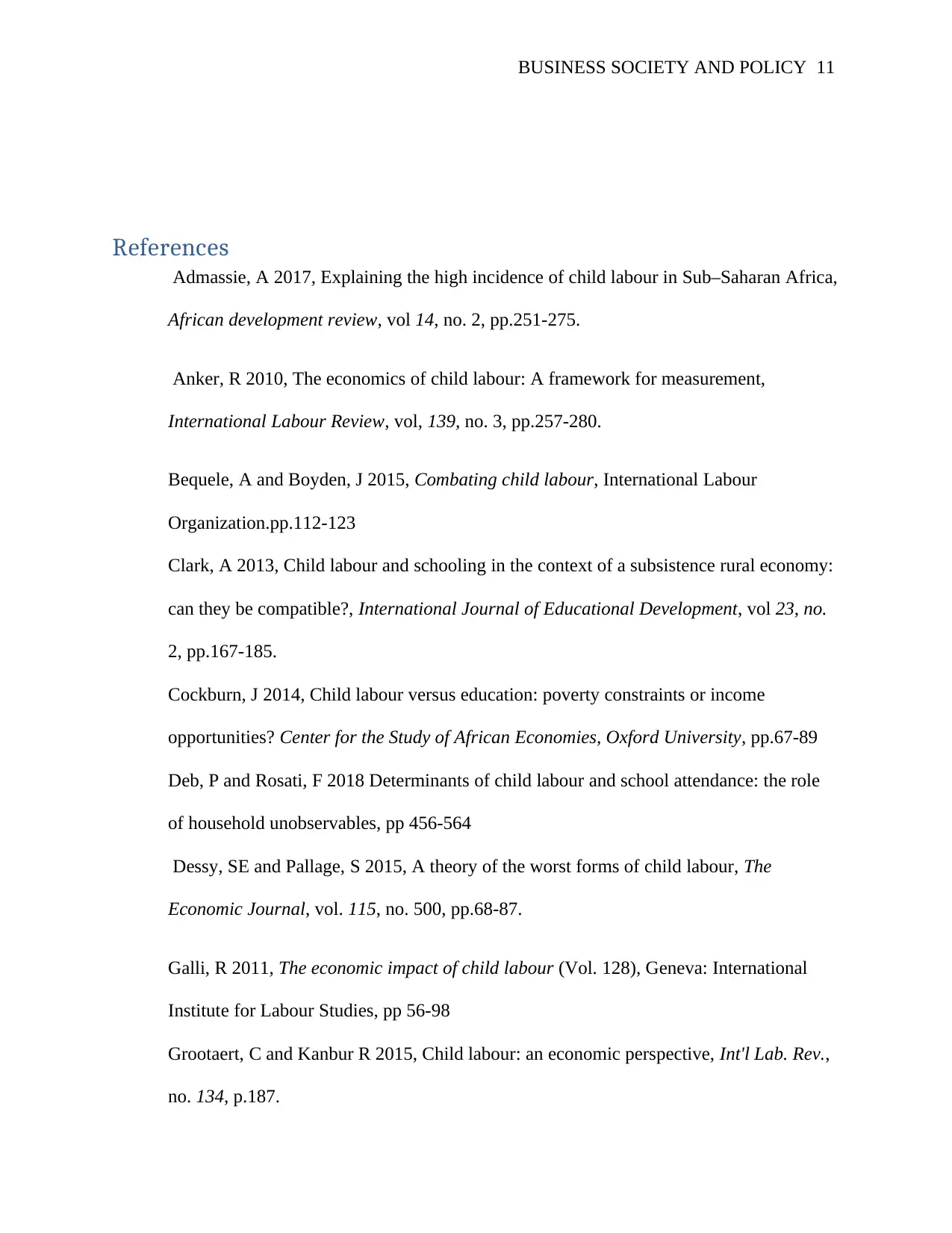
BUSINESS SOCIETY AND POLICY 11
References
Admassie, A 2017, Explaining the high incidence of child labour in Sub–Saharan Africa,
African development review, vol 14, no. 2, pp.251-275.
Anker, R 2010, The economics of child labour: A framework for measurement,
International Labour Review, vol, 139, no. 3, pp.257-280.
Bequele, A and Boyden, J 2015, Combating child labour, International Labour
Organization.pp.112-123
Clark, A 2013, Child labour and schooling in the context of a subsistence rural economy:
can they be compatible?, International Journal of Educational Development, vol 23, no.
2, pp.167-185.
Cockburn, J 2014, Child labour versus education: poverty constraints or income
opportunities? Center for the Study of African Economies, Oxford University, pp.67-89
Deb, P and Rosati, F 2018 Determinants of child labour and school attendance: the role
of household unobservables, pp 456-564
Dessy, SE and Pallage, S 2015, A theory of the worst forms of child labour, The
Economic Journal, vol. 115, no. 500, pp.68-87.
Galli, R 2011, The economic impact of child labour (Vol. 128), Geneva: International
Institute for Labour Studies, pp 56-98
Grootaert, C and Kanbur R 2015, Child labour: an economic perspective, Int'l Lab. Rev.,
no. 134, p.187.
References
Admassie, A 2017, Explaining the high incidence of child labour in Sub–Saharan Africa,
African development review, vol 14, no. 2, pp.251-275.
Anker, R 2010, The economics of child labour: A framework for measurement,
International Labour Review, vol, 139, no. 3, pp.257-280.
Bequele, A and Boyden, J 2015, Combating child labour, International Labour
Organization.pp.112-123
Clark, A 2013, Child labour and schooling in the context of a subsistence rural economy:
can they be compatible?, International Journal of Educational Development, vol 23, no.
2, pp.167-185.
Cockburn, J 2014, Child labour versus education: poverty constraints or income
opportunities? Center for the Study of African Economies, Oxford University, pp.67-89
Deb, P and Rosati, F 2018 Determinants of child labour and school attendance: the role
of household unobservables, pp 456-564
Dessy, SE and Pallage, S 2015, A theory of the worst forms of child labour, The
Economic Journal, vol. 115, no. 500, pp.68-87.
Galli, R 2011, The economic impact of child labour (Vol. 128), Geneva: International
Institute for Labour Studies, pp 56-98
Grootaert, C and Kanbur R 2015, Child labour: an economic perspective, Int'l Lab. Rev.,
no. 134, p.187.
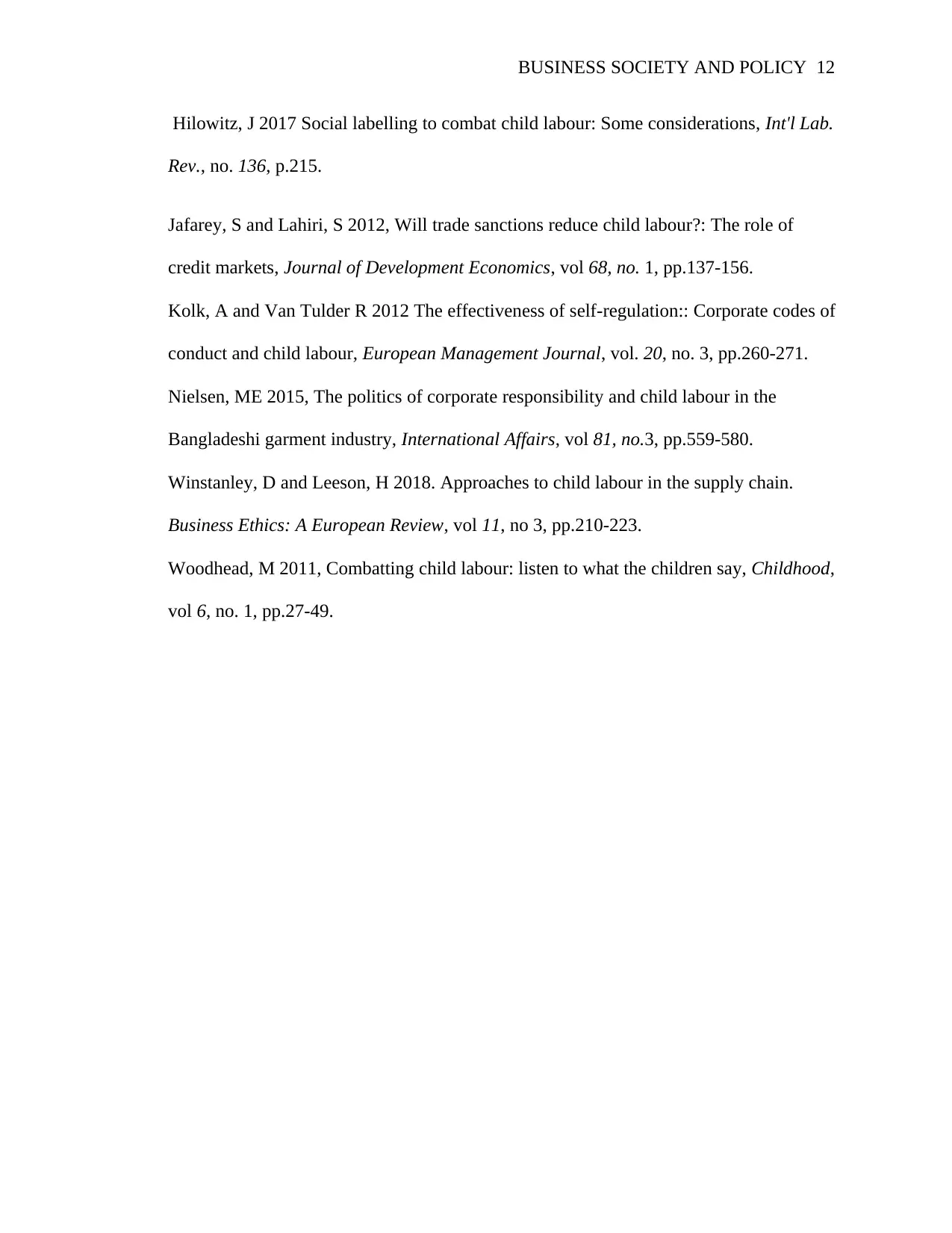
BUSINESS SOCIETY AND POLICY 12
Hilowitz, J 2017 Social labelling to combat child labour: Some considerations, Int'l Lab.
Rev., no. 136, p.215.
Jafarey, S and Lahiri, S 2012, Will trade sanctions reduce child labour?: The role of
credit markets, Journal of Development Economics, vol 68, no. 1, pp.137-156.
Kolk, A and Van Tulder R 2012 The effectiveness of self-regulation:: Corporate codes of
conduct and child labour, European Management Journal, vol. 20, no. 3, pp.260-271.
Nielsen, ME 2015, The politics of corporate responsibility and child labour in the
Bangladeshi garment industry, International Affairs, vol 81, no.3, pp.559-580.
Winstanley, D and Leeson, H 2018. Approaches to child labour in the supply chain.
Business Ethics: A European Review, vol 11, no 3, pp.210-223.
Woodhead, M 2011, Combatting child labour: listen to what the children say, Childhood,
vol 6, no. 1, pp.27-49.
Hilowitz, J 2017 Social labelling to combat child labour: Some considerations, Int'l Lab.
Rev., no. 136, p.215.
Jafarey, S and Lahiri, S 2012, Will trade sanctions reduce child labour?: The role of
credit markets, Journal of Development Economics, vol 68, no. 1, pp.137-156.
Kolk, A and Van Tulder R 2012 The effectiveness of self-regulation:: Corporate codes of
conduct and child labour, European Management Journal, vol. 20, no. 3, pp.260-271.
Nielsen, ME 2015, The politics of corporate responsibility and child labour in the
Bangladeshi garment industry, International Affairs, vol 81, no.3, pp.559-580.
Winstanley, D and Leeson, H 2018. Approaches to child labour in the supply chain.
Business Ethics: A European Review, vol 11, no 3, pp.210-223.
Woodhead, M 2011, Combatting child labour: listen to what the children say, Childhood,
vol 6, no. 1, pp.27-49.
⊘ This is a preview!⊘
Do you want full access?
Subscribe today to unlock all pages.

Trusted by 1+ million students worldwide
1 out of 12
Related Documents
Your All-in-One AI-Powered Toolkit for Academic Success.
+13062052269
info@desklib.com
Available 24*7 on WhatsApp / Email
![[object Object]](/_next/static/media/star-bottom.7253800d.svg)
Unlock your academic potential
Copyright © 2020–2025 A2Z Services. All Rights Reserved. Developed and managed by ZUCOL.





